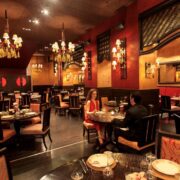
The restaurant industry has always been competitive, with establishments constantly looking for ways to set themselves apart and attract new customers. In recent years, the rise of technology has led to innovative solutions that have revolutionized various industries – and the restaurant industry is no exception. One such solution is geofencing, which uses location-based services to target potential customers in a specific area with personalized messages or offers. This technology is quickly gaining traction in the food service sector as it allows restaurants to reach out directly to diners and create unique experiences. In this blog post, we will delve into how restaurant geofencing works, its benefits for both businesses and customers and some real-life examples of how it’s changing the dining experience. If you’re a restaurateur looking for new ways to stay ahead in a competitive market or simply interested in learning about emerging technologies impacting the food service industry – this post is for you!
Geofencing technology and its growing popularity in the restaurant industry
Geofencing technology is rapidly gaining ground in the restaurant industry. This innovative tool enables businesses to draw virtual boundaries around their physical locations, allowing them to directly target customers within a specific geographic area. As customers enter the geofenced zone, they receive customized notifications based on predetermined criteria set by the restaurant. Such notifications may include promotional discounts, special offers, or new menu items. With geofencing technology, restaurants can optimize their marketing strategies, boost customer engagement, and increase foot traffic to their establishments. As this technology continues to develop, it is expected to revolutionize the way restaurants reach and communicate with their customers.
How geofencing works and what it can do for restaurants
Geofencing is a location-based technology that involves creating a virtual boundary around a particular area using GPS or Radio Frequency Identification (RFID) technology. This innovative technology is increasingly being used in the restaurant industry to enhance customer experience and improve business operations. By creating a designated geofenced area, restaurants can send targeted marketing messages, promotions, and offers to customers within proximity. Additionally, geofencing can help owners and managers keep track of staff movements, monitor inventory and deliveries, and enhance overall security on the premises. Implementing geofencing technology can be an effective tool for restaurants to attract customers, manage operations, and ultimately increase revenue.
Benefits of restaurant geofencing for both customers and owners
Restaurant geofencing in Atlanta is becoming increasingly popular among both customers and owners. With geofencing, restaurants can send location-based promotions directly to potential customers in the area, increasing foot traffic and ultimately increasing sales. For customers, receiving personalized discounts and promotions based on their location can be a huge incentive to visit the restaurant. Furthermore, geofencing allows restaurants to gather valuable data about their customers’ behavior and preferences, allowing them to tailor their marketing efforts accordingly. Overall, restaurant geofencing has proven to be a beneficial tool for both customers and owners alike.
Addressing potential concerns about privacy and data collection with geofencing
In today’s digital landscape, geofencing offers a powerful tool for businesses to connect with customers and conduct targeted marketing campaigns. However, as with any data collection method, there are legitimate concerns about privacy and security. Companies must address these concerns head-on by being transparent about the data they are collecting and how it will be used. By implementing clear and concise privacy policies, businesses can demonstrate their commitment to protecting their user’s information and build trust with their customers. Additionally, companies can explore anonymization techniques and other privacy-enhancing technologies to further safeguard user data. Ultimately, by prioritizing privacy and data protection, businesses can leverage the many benefits of geofencing, while also maintaining user trust and mitigating risks.
Potential impact of geofencing on the future of dining out
Over the last decade, the restaurant industry has undergone a significant transformation thanks to advancements in technology. One technology that is starting to gain traction is geofencing. This location-based service allows restaurants to create a virtual boundary around a designated area, which triggers a notification or alert to a customer’s phone. The potential impact of geofencing on the future of dining out is vast. Restaurants can use this technology to directly target consumers in the vicinity, offering them personalized deals and promotions. On the other hand, it can also streamline the ordering process by notifying the restaurant when a customer enters the geofenced zone, allowing them to prepare the order before the customer even arrives. As geofencing technology continues to evolve, we can expect it to play an even more significant role in the restaurant industry, providing a more personalized dining experience for customers and increased efficiency for restaurants.
Geofencing technology offers exciting possibilities for restaurants to reach customers in new ways. As we have seen, when implemented thoughtfully with privacy and ethical data usage in mind, geofencing enables restaurants to provide personalized promotions, build customer loyalty, and boost sales. While not without challenges, the success stories shared here showcase the power of location-based marketing. Looking ahead, we can expect geofencing to evolve along with shifts in consumer behavior and technology. Restaurants that embrace innovations like geofencing with care and strategic vision are poised to thrive in the competitive dining sector. Though uncertainties remain regarding data regulation, consumers today expect highly customized dining experiences, making location-based engagement tactics an important piece of the hospitality industry landscape now and for years to come. I welcome readers to share their thoughts and questions in the comments below.










